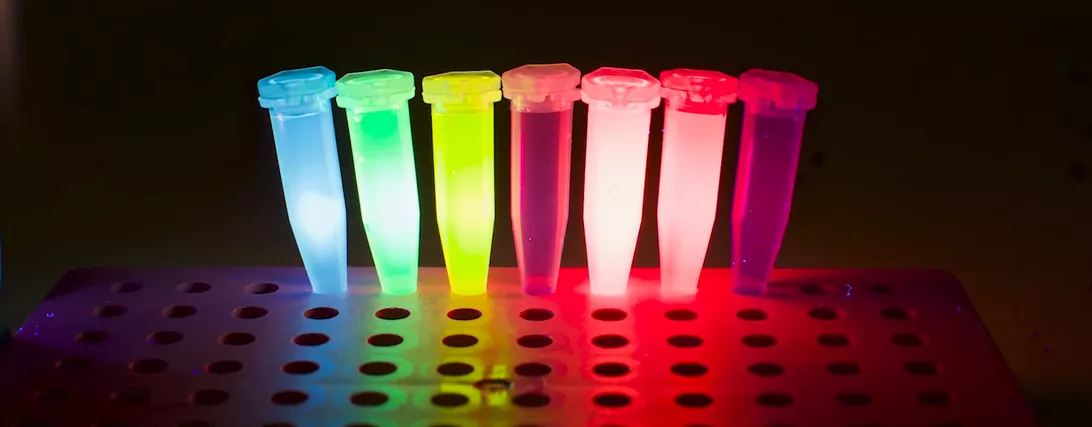The rapid increase in the use of digital technologies has necessitated the rethinking of data storage methods. Devices employed to store data (magnetic media, optical media, and flash memory) have inadequate operational lifetimes for long-term storage, along with significant energy to maintain the gathered data.
 You could potentially store your precious baby photos as fluorescent dyes. Image Credit: American Chemical Society.
You could potentially store your precious baby photos as fluorescent dyes. Image Credit: American Chemical Society.
Scientists from Harvard came up with a colorful way of storing digital information by using mixtures of fluorescent dyes. They anticipate these to replace the bulky, hackable, energy-burning magnetic tapes still used to store valuable data.
The current study demonstrates that digital data can be stored in mixtures of fluorescent dye molecules, which are deposited on a surface by inkjet printing, where an amide bond tethers the dye molecules to the surface.
The New Storage Approach
The novel approach is a write-once-read-many (WORM) molecular information approach with mixtures of fluorescent dye molecules covalently attached to an epoxy substrate. An inkjet printer allows the writing of information at a rate of 16 bytes/second, and a multichannel fluorescence detector in a confocal microscope enables reading at a rate of 58 kilobytes/second.
The information can be stored in the composition of a mixture of oligopeptides.
The method allows information storage with high density, fast read/write speeds, and multiple reads of a single set of molecules without loss of information, being cost-effective at the same time.
Advantages
The molecular information storage technique has numerous advantages when compared to magnetic tape: (i) Information can be stored, presumably, with lower environmental and power requirements; (ii) information can be stored at low costs; (iii) parallelized reading of information, a single image file can be used to read the information; (iv) information can be encrypted with novel schemes.
Prerequisites for the Approach
Seven commercially available fluorescent dye molecules with various emission maxima were selected. The dyes were dissolved in dimethyl sulfoxide (DMSO), filtered through a 0.45 μm polysulfone syringe filter, and injected into the inkjet printer cartridge.
An ink-jet printer—inkjet printing is a material deposition technique—was employed to permanently dot the mixtures onto a small section of an already tiny slide.
Fluorescence imaging is a powerful tool for the high-resolution characterization of biological samples and materials. A Zeiss LSM 800 fluorescence microscope was used. In this technique, fluorescence emission passes through a pinhole and is separated by wavelength by a diffraction grating.
An amide bond is one of the most thermodynamically stable bonds and perfectly suits the long-term storage of information. N-hydroxysuccinimide-functionalized dye molecules, which spontaneously react with amino groups to form amide bonds, were used. It is vital to have a flat surface for the substrate as irregularities in thickness lead to blurring of the image.
A binary representation consists of eight bits where each bit is either “0” or “1.” In this encoding scheme, the bit string is assigned a position which in turn is assigned to a fluorescent dye molecule in the order of increasing emission maxima. The bit strings for the positions are then used to generate a printable pattern. “0” indicates the absence of a dye molecule, and “1” indicates the presence of a dye molecule.
The Process
The dye molecules were deposited onto the substrate with an inkjet printer. The substrate with the written information was placed in a Zeiss LSM 880 fluorescence microscope in an inverted configuration. Using the in-built spectral imaging function, all the patterns were resolved with a very good spatial resolution for each dye.
Decoding the Information
The individual patterns are read using a simple Python program script using the OpenCV computer vision library. Around 99.64% was obtained from the recovered information. The accuracy can be enhanced with more sophisticated image analysis techniques and error correction codes.
Shining Light on a New Fluorescent Data Storage Technique | Headline Science
Shining Light on a New Fluorescent Data Storage Technique. Video Credit: American Chemical Society.
Conclusion
The novel molecular data storage technology leverages the optical characteristics of conjugated molecules. A multichannel fluorescence detector allows the simultaneous and independent detection of the presence or absence of a molecule in a mixture on a surface.
With this approach, around 14,075 bytes of digital information were written and read more than 1000 times without significant loss (less than 20%) in fluorescent signal intensity. This approach provides information storage with high density, fast read/write speeds, and multiple reads of a single set of molecules without loss of information, all at an acceptable cost.
Journal Reference:
Nagarkar, A. A., et al. (2021) Storing and Reading Information in Mixtures of Fluorescent Molecules. ACS Central Science. doi.org/10.1021/acscentsci.1c00728.